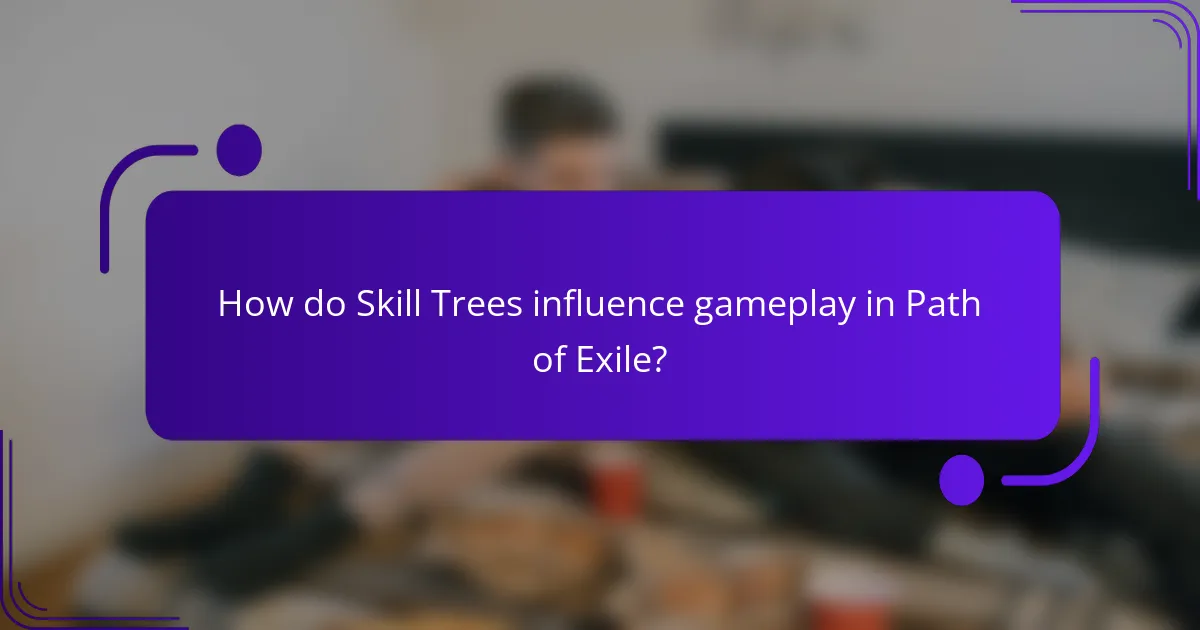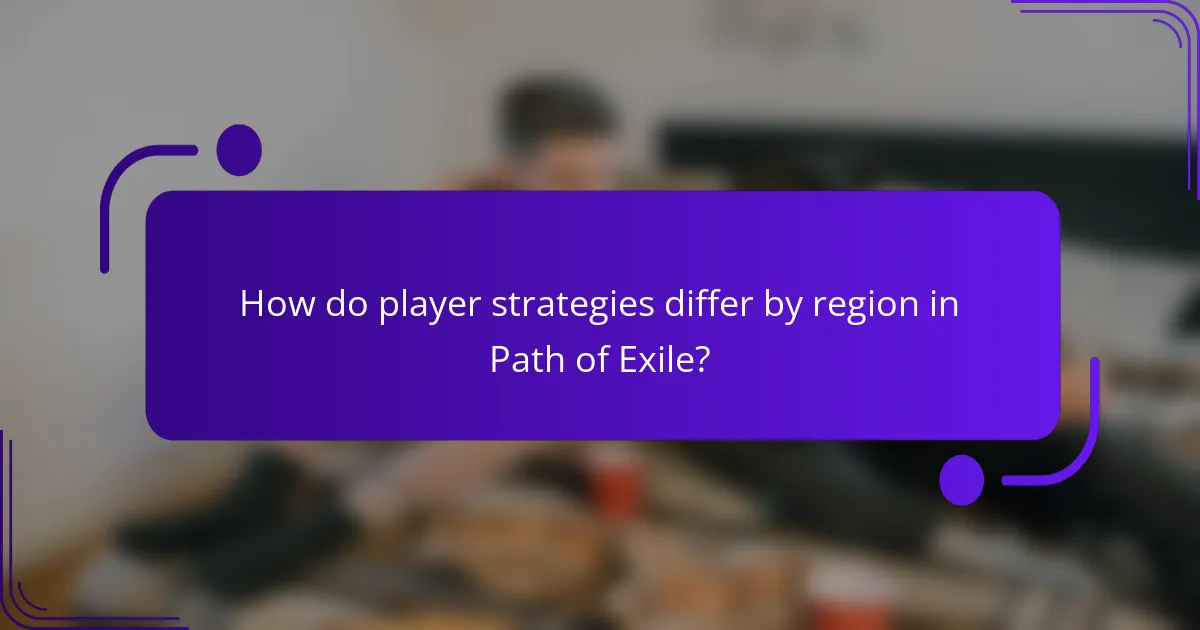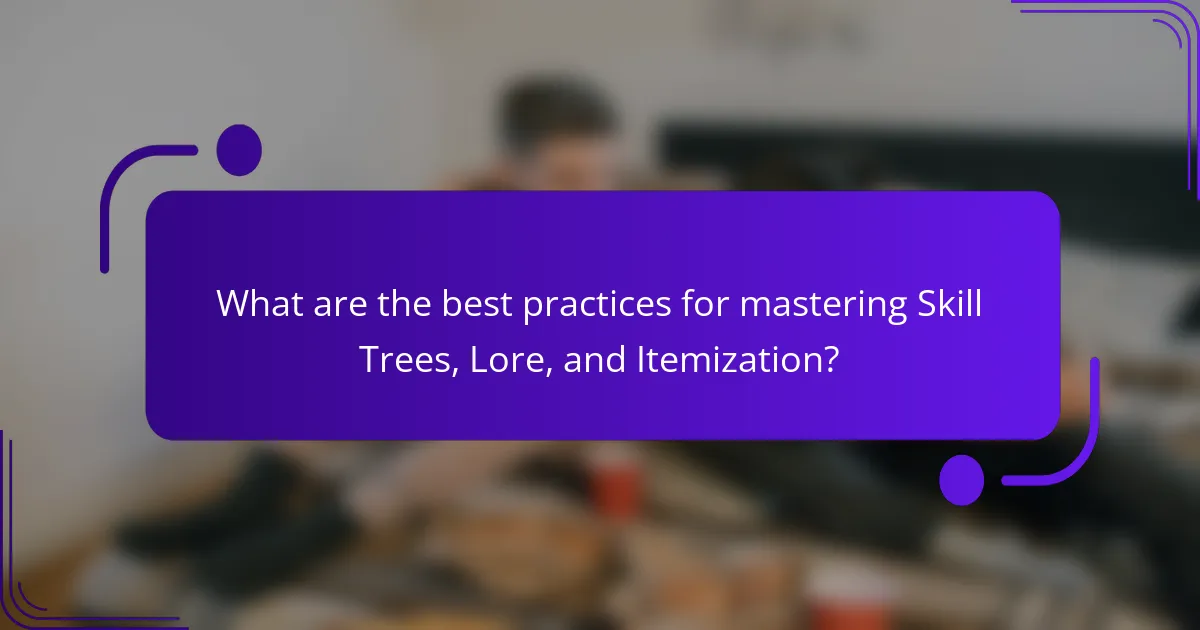Understanding skill trees, lore, and itemization is essential for maximising your gameplay in Path of Exile. Skill trees offer customisable character builds through unique passive skills. The game’s intricate lore enriches the narrative and informs gameplay choices. Effective itemization involves managing gear, crafting, and understanding item attributes to enhance character performance.

How do Skill Trees influence gameplay in Path of Exile?
Skill trees significantly influence gameplay in Path of Exile by providing players with customisable character builds. Each skill tree allows for diverse playstyles through unique attributes like passive skills, which enhance specific abilities or stats. This depth encourages strategic planning, as players must consider their choices carefully to optimise their character’s performance. Additionally, the interconnected nature of skill trees fosters experimentation, enabling players to explore various synergies and combinations, ultimately shaping their gaming experience.
What are the core mechanics of Skill Trees?
Skill trees in Path of Exile enable players to customise their characters through a complex web of passive skills. These mechanics allow for strategic choices that define a player’s build and playstyle. Players navigate the skill tree to allocate points into various nodes, enhancing attributes like strength, dexterity, and intelligence. Unique nodes can provide specialised bonuses, while root attributes enhance fundamental character capabilities. The interconnectivity of skill nodes offers rare combinations, leading to diverse and powerful character builds.
Which classes benefit most from specific Skill Trees?
Classes that benefit most from specific Skill Trees in Path of Exile include the Witch with Intelligence-based trees, the Duelist with hybrid options, and the Marauder focusing on Strength. Each class excels when aligned with its corresponding Skill Tree attributes. For example, the Witch thrives on spellcasting enhancements, while the Marauder gains significant physical damage boosts. Unique Skill Trees like the Ascendant allow for versatile builds, catering to diverse playstyles. Understanding these connections enhances gameplay effectiveness and strategic planning.
How do Skill Tree choices affect character builds?
Skill tree choices significantly impact character builds by determining available skills and playstyle. Each node in the skill tree enhances specific attributes, influencing damage output, survivability, and utility. Players can tailor their builds through unique combinations, allowing for diverse strategies. The selection of passive skills also affects interactions with items, further customising gameplay experiences.
What strategies can players use to optimise their Skill Trees?
Players can optimise their Skill Trees in Path of Exile by focusing on specific strategies. First, prioritise key passive skills that enhance your character’s strengths. Second, consider the synergy between skills and gear, ensuring they complement each other. Third, use online tools to simulate builds and test different configurations before committing. Lastly, regularly reassess your build as new content is released, adapting to changes in gameplay and meta. These strategies will help maximise effectiveness and efficiency in gameplay.

What role does lore play in shaping Path of Exile’s world?
Lore plays a crucial role in shaping Path of Exile’s world by providing depth and context to its narrative. It enriches the gameplay experience, connecting players to the game’s history and characters. The intricate lore informs the design of skill trees and itemization, influencing character development and player choices. Unique attributes of the lore, such as its dark themes and complex narratives, differentiate Path of Exile from other action RPGs. This immersive storytelling enhances player engagement and fosters a deeper emotional connection to the game world.
How does the lore influence character motivations and quests?
Lore significantly shapes character motivations and quests in Path of Exile. The rich narrative background provides context for characters’ actions and decisions, influencing their goals and alliances. Characters often seek revenge, redemption, or power, driven by personal histories tied to the lore. For example, the struggle against ancient evils or the quest for lost knowledge motivates many players’ paths. This connection between lore and character development enhances the immersive experience, making quests feel meaningful and engaging. The unique attributes of specific characters, like their tragic pasts or ambitions, further deepen player investment in their journeys.
Which key events from the lore impact gameplay mechanics?
Key events from the lore significantly influence gameplay mechanics in Path of Exile. For example, the fall of the Eternal Empire introduces unique skill interactions and itemization changes. The rise of the Beast and the conflict with the gods affect character abilities and narrative-driven quests. Additionally, the introduction of the Atlas of Worlds alters map mechanics, emphasising exploration and player choice. Each lore event shapes gameplay, creating a dynamic and immersive experience that ties story elements to player progression.
How do players engage with lore through in-game content?
Players engage with lore in Path of Exile through skill trees and itemization, enriching their gameplay experience. The skill trees reflect character development and narrative depth, allowing players to craft unique builds that resonate with the game’s lore. Itemization further enhances this connection, as items often carry backstories and lore-related attributes. Players discover these narratives through item descriptions and quest dialogues, which provide context and historical significance, deepening their immersion in the game’s world. This interplay between gameplay mechanics and storytelling fosters a rich, engaging experience for players.

What are the essential aspects of itemization in Path of Exile?
Itemization in Path of Exile involves managing gear, crafting, and enhancing items to optimise character builds. Essential aspects include item rarity, affixes, and crafting mechanics. Rarity affects item power and drop rates, while affixes determine item attributes such as damage or resistance. Crafting allows players to modify items, adding unique attributes or enhancing existing ones. Understanding these elements is crucial for maximising effectiveness in gameplay.
How does item rarity affect gameplay experience?
Item rarity significantly enhances the gameplay experience in Path of Exile by influencing item value and player engagement. Rare items often provide unique attributes that shape character builds and strategies. Players are motivated to explore and farm for these items, creating a deeper connection to the game’s lore and itemization system. Additionally, the thrill of discovering a rare item can lead to a sense of achievement, enriching the overall experience.
What types of items are crucial for character progression?
Crucial items for character progression in Path of Exile include weapons, armour, accessories, skill gems, and currency items. Weapons enhance damage output, while armour increases survivability. Accessories provide additional stats and bonuses. Skill gems enable new abilities and modify existing ones. Currency items facilitate crafting and trading, essential for optimising gear.
Which unique items provide significant gameplay advantages?
Unique items in Path of Exile that provide significant gameplay advantages include the following:
1. The Shroud of the Lightless: Grants increased movement speed and enhanced evasion, ideal for agile builds.
2. The Headhunter: Provides temporary buffs from slain enemies, boosting damage and survivability.
3. The Mirror of Kalandra: Allows duplication of any item, creating rare opportunities for powerful gear.
4. The Dying Sun: Increases area of effect and grants additional projectiles, enhancing area damage capabilities.
5. The Starforge: Delivers high physical damage and converts a portion to fire damage, perfect for melee builds.
6. The Abyssus: Offers a significant boost to damage at the cost of increased damage taken, rewarding aggressive playstyles.
These unique items exemplify rare attributes that can dramatically alter gameplay dynamics in various builds.
How do crafting and modifiers enhance itemization strategies?
Crafting and modifiers significantly enhance itemization strategies by allowing players to customise gear for optimal performance. Crafting enables the alteration of item attributes, tailoring them to specific builds. Modifiers add unique effects, creating synergies that enhance gameplay. This flexibility encourages diverse playstyles and strategies. Moreover, the combination of crafted items with rare modifiers can lead to powerful gear that supports endgame content effectively.

How do player strategies differ by region in Path of Exile?
Player strategies in Path of Exile differ significantly by region due to cultural preferences and gameplay styles. In North America, players often prioritise speed and efficiency, favouring builds that maximise damage output and quick map clears. Conversely, European players tend to focus on strategy and synergy, often experimenting with more complex builds that emphasise team play and unique item combinations. In Asia, particularly in regions like Korea, there is a strong inclination towards competitive play, with players optimising for high-level endgame challenges. These regional differences shape the overall meta, influencing choices in skill trees and itemization.
What are the common challenges faced by players in North America?
Players in North America face several common challenges in Path of Exile. These include high competition in endgame content, frequent game updates that alter mechanics, and the complexity of skill trees. Additionally, players often struggle with itemization and crafting, which can be overwhelming due to the vast number of options available. The learning curve for new players can also be steep, leading to frustration. Lastly, server latency issues can affect gameplay experience, especially during peak hours.
How do European players approach Skill Tree optimisation differently?
European players approach Skill Tree optimisation in Path of Exile with a focus on strategic synergy and community-driven experimentation. They often prioritise builds that maximise efficiency and effectiveness in gameplay.
For instance, many European players emphasise the importance of endgame viability, favouring skill trees that enhance damage output and survivability. They frequently collaborate in forums and social media to share insights, leading to innovative build designs.
Additionally, European players tend to adopt a more analytical approach, utilising tools and simulations to refine their skill tree choices. This contrasts with more casual approaches seen in other regions, where experimentation may take precedence over optimisation.
Ultimately, the combination of community engagement and analytical rigor shapes the distinct optimisation strategies among European players in Path of Exile.
What unique itemization trends are observed in Japan?
Japan exhibits unique itemization trends in Path of Exile through cultural influences and game mechanics. Players often favour rare items with unique attributes that enhance gameplay, reflecting a preference for customisation. The integration of lore into item design creates a deeper connection for players, making items not just tools but also storytelling elements. Additionally, community-driven events and trading systems emphasise the value of specific items, leading to trends that prioritise rarity and utility in character builds.

What are the best practices for mastering Skill Trees, Lore, and Itemization?
To master Skill Trees, Lore, and Itemization in Path of Exile, focus on strategic planning, understanding item synergies, and engaging with the game’s narrative.
Begin by researching optimal skill tree builds that complement your chosen character class. Use community resources to identify effective combinations of passive skills that enhance your gameplay.
Next, immerse yourself in the lore to appreciate the game’s depth, which can inform your choices and enrich your experience. Understanding the backstory and character motivations can provide context for itemization and skill selection.
Lastly, prioritise itemization by learning about unique items and their attributes. Familiarise yourself with crafting mechanics and the importance of modifiers to maximise your character’s potential. Balancing these elements will lead to a more rewarding gameplay experience.